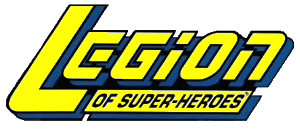1989-1993: LSH v. 4 Giffbaum era

In 1989, DC Comics (in all its infinite wisdom) decided that it was time to kill the Legion of Super-Heroes. As executioners,they chose fan writers Tom & Mary Bierbaum, and Keith Giffen, whose art had been steadily deteriorating for years. The comic ceased publication with issue #63, and a new Legion of Super-Heroes (designated "version 4") began with issue #1. It was five years later, and the Legion's bright, optimistic universe had turned ugly and depressing. The Legion had disbanded, various former Legionnaires had suffered terrible tragedies, and storytelling skills had vanished. The new series was stultifying and all but impenetrable even to long-time Legion fans. The art was murky, distorted, and full of shadows, making it hard to distinguish characters from one another. Cues such as brightly-colored, individualistic costumes were eliminated. Every page was rendered in a strict nine-panel grid, increasing the monotony. (Several pages consisted of totally-black panels, with only word balloons from unidentified speakers.) If the creators were trying to remove the visual component from comic books, they very nearly succeeded. The storyline -- such as it was -- matched the art perfectly. Readers were given no background, but left to reconstruct the great changes in the universe and the Legion themselves, mainly from dialogue. Text pages, in the form of history books and diary entries, gave copious information about the most minor details, while totally ignoring major elements. Super-hero code names were eliminated -- the Legionnaires referred to one another exclusively by first name -- which made it even more difficult for readers to know who was who. New characters were dropped in with no hint of their background, identity, or powers. To further complicate matters, the first six issues saw three entirely different alternate universes, without any explicit explanation. Small wonder that the creative team found it necessary to include a short text box on each letters page, telling what had purportedly happened in the previous issue (the fact that they were able to fit twenty pages of "story" into two short paragraphs indicates how little actual "story" was there.) The fan-fiction background of the writers was painfully obvious, as they launched into wholescale rewrites of established Legion continuity, enshrining all their pet theories from their fanzine stories. Mon-El had, for years, been possessed by his remote cousin Eltro Gand. Lightning Lad wasn't really Lightning Lad (and never had been), he was really the original Proty. Superboy never existed...well, yes he did, but only for a few weeks...no, he did exist and he was from the Pocket Universe after all. Mon-El had never been called "Mon -El," he had always been "Valor." Shvaughn Erin had been a boy all along. There was no Supergirl (and never had been), only an identical tall blonde named Laurel Gand. One of the first Legionnaires, oh-didn't-we-tell-you?, was some idiot named Kid Quantum. Anything the creative team didn't like (such as Matter-Eater Lad or Legion code-names), they felt obliged to ridicule; one can just see them sitting around a few beers laughing themselves silly at their own jokes.) The amateurish quality of the writing can best be described as the "pull something out of a hat" school -- plot elements were introduced on the spur of the moment, because they sounded good, with no consideration for established continuity or for how those elements would affect the future. Several atrocious cover blurbs showed the contempt that the creative team had for the readers: "At Last: Whatever Happened to Kid Quantum?" (on the issue introducing Kid Quantum) and "The Battle You've Been Waiting For: Bounty vs. Sade" (Half the readers weren't even aware that Bounty and Sade were two separate characters, much less that we had been waiting for a battle between the two.) To cap all the confusion, a second Legion of Super-Heroes was introduced, younger versions of the current team. One set, it seemed, were clones...but was it the current Legionnaires, or the newcomers? The creative team themselves, it seemed, didn't even know...or they had changed their minds so often, that the result was the same. The main focus of the book was on violence, blood, and messy deaths. Not content with killing Legionnaires, their friends and families, and thousands of innocent bystanders, the creative team first blew up the Moon (peppering Earth with fragments that slaughtered millions), then (as an encore) destroyed the Earth itself. Madness and senseless cruelty were constant features. The new, gritty Legionnaires had no compunctions about killing their enemies, and suffered no consequences when they did so. At one point, the entire Legion gladly joined the army and went off gladly slaughtering Khunds and Dominators. Betrayal and corruption were everywhere, from the ranks of the Legion itself to the government of Earth and into the highest levels of the United Planets. During this period, Legion readership and sales declined to the lowest they had ever been, and fans (even myself) begged for cancellation. Die-hard Legion fans, reading the entire series at once (rather than waiting for individual issues to come out once a month) can probably get something out of these comics -- if they are fully conversant with Legion history, and have copies of the various Who's Who and Mayfair Games background materials. Otherwise, reading them is an exercise in frustration, tedium, and disgust. Two Legion spinoffs started in this period: the short-lived Timber Wolf series, and Valor. For a few months there, it was possible to buy a Legion-related title every week (and to regret doing so.) (The real excitement in this period was going on in the LSH spinoff title L.E.G.I.O.N. [affectionately known as "LEGIRON"], where many of the same issues [violence, betrayal, death] were being dealt with skillfully.) In the end, it turned out that there were many alternate Legions, and that the Giffbaum/Gloirthverse version was simple one of them (albeit one of the worst).












